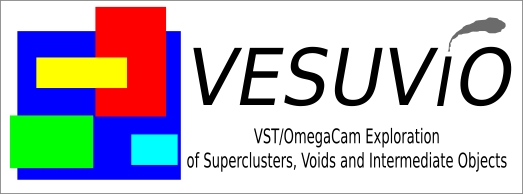
WORKING GROUP SPECTROSCOPIC SURVEY
Tasks
- complete down to Bj=17.5 the Horologium redshift survey
- define and carry out a spectroscopic survey of Horologium to obtain redshifts for fainter galaxies (magnitude-limited, TBD) for LSS, LS dynamics and LFs
- outline the spectroscopic follow-up at VLT and preparing the relative proposals
- Aims of the VLT spectroscopy are
- to obtain spectroscopic characterisation (stellar populations, SFR, etc...) of galaxies belonging to the full range of environments, both in local (z=0.05) and in distant (z=0.3-0.5) structures;
- to derive internal kinematics (scaling laws) for fair
samples of galaxies
- to derive scaling laws and stellar population
properties for magnitude-limited samples in the "ultra deep" field.
- This leads to an estimated need of 30 nights for the local sample, 28 nights for the distant sample, and 15 nights for the "ultra deep" field (this last to be coordinated with the supernovae survey). In total, we estimate that we need 55 VIMOS nights for the completion of the bulk of the VESUVIO survey, plus 15 nights for the ultra-deep field coordinated with the supernovae survey. This requires approximately 70 VLT-VIMOS nights.
- define and carry out a spectroscopic survey of Hercules to obtain redshifts (magnitude-limited, TBD) for LSS and LS dynamics and LFs
- find other facilities for redshifts- AAOmega
Persons
-
Paola Merluzzi, Scott Trager, Jim Rose, Matthew Fleenor,
Gianni Busarello, Massimo Capaccioli,
Amata Mercurio, FL B, Reynier Peletier, Manolis Plionis, A. Rifatto, G.
Sorrentino, Rien van de Weijgaert
Documents
Pages maintained by Gijs Verdoes Kleijn,

